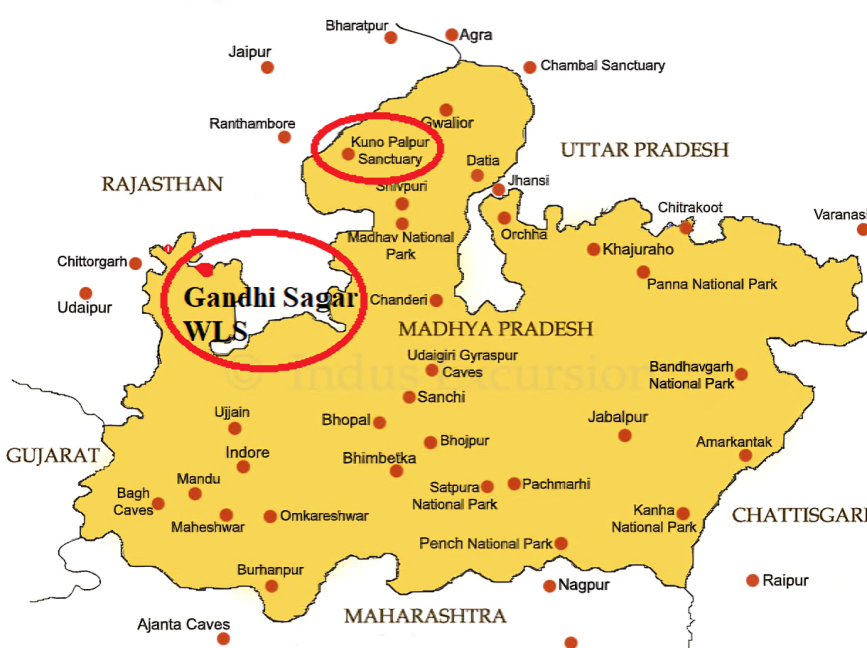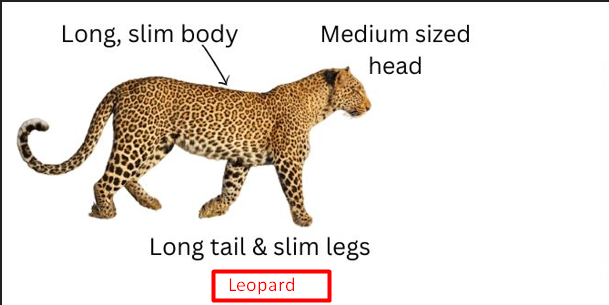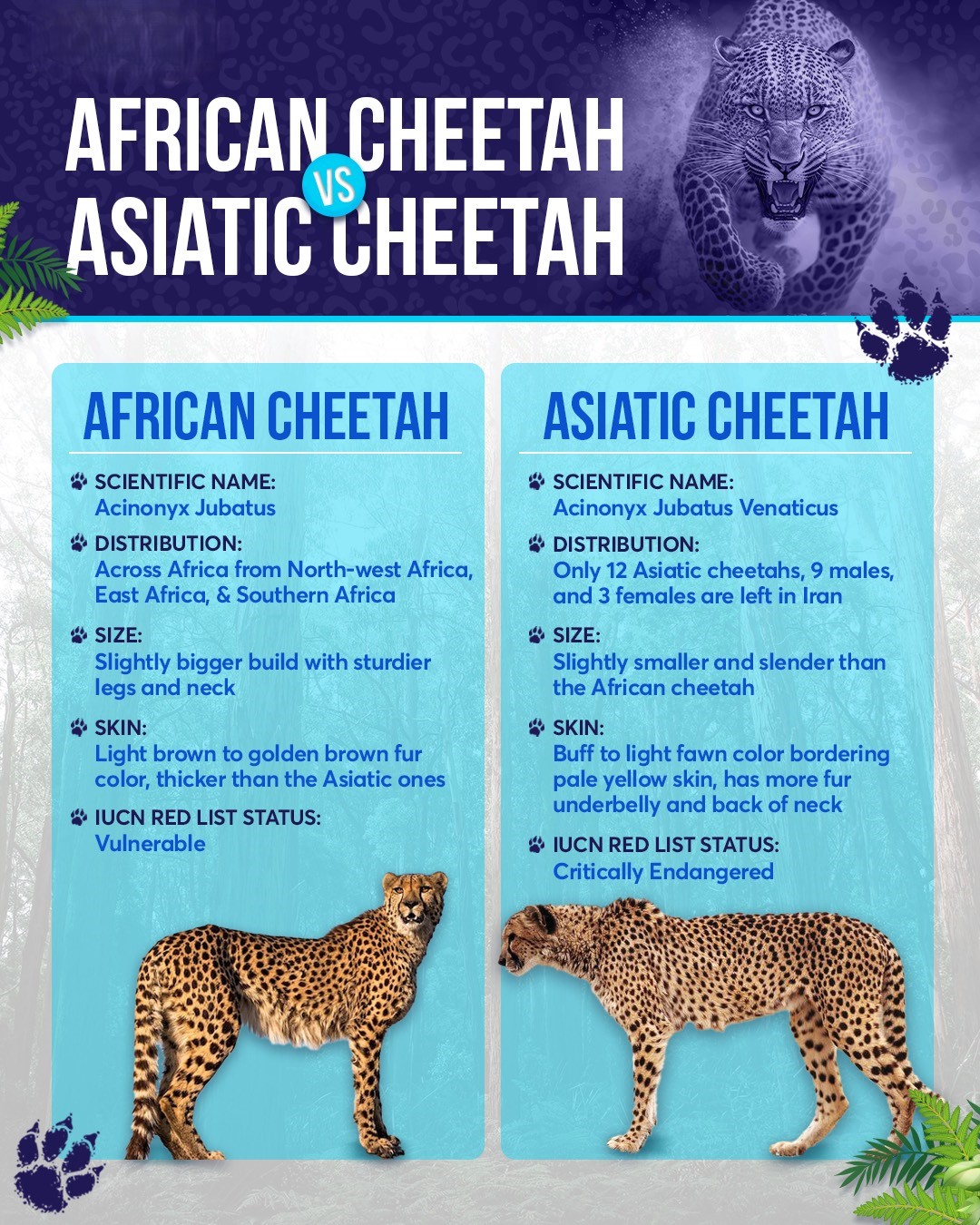Cheetahs in Gandhi Sagar Wildlife Sanctuary | 19 Jun 2024
For Prelims: Cheetah Reintroduction Plan, Kuno-Palpur National Park (KNP), CITES, Project Cheetah, Gandhi Sagar Wildlife Sanctuary.
For Mains: Challenges Associated with the Translocation of Cheetah in India, Importance of Biodiversity, Genetic, Species, Ecosystem.
Why in News?
Recently, the Madhya Pradesh Government has informed that it has completed its preparations for the reintroduction of the cheetahs from Africa in the Gandhi Sagar Wildlife Sanctuary (GSWS).
- It will be the second home for cheetahs in India, after the Kuno National Park (KNP).
Project Cheetah
- Phase-1 of the project started in 2022, to restore the population of cheetahs, which were declared extinct in the country in 1952.
- It involves the translocation of cheetahs from South Africa and Namibia to Kuno National Park.
- The project is implemented by the NTCA in collaboration with the Madhya Pradesh Forest Department, and Wildlife Institute of India (WII).
- Under Phase-2 of the Project India is considering sourcing cheetahs from Kenya due to similar habitats.
- Cheetahs will be translocated to Kuno National Park and Gandhi Sagar Wildlife Sanctuary (Madhya Pradesh).
What are Key Facts About Gandhi Sagar Wildlife Sanctuary?
- Location:
- Notified in 1974, encompassing the districts of Mandsaur and Neemuch in western Madhya Pradesh, bordering Rajasthan.
- The Chambal River bifurcates the sanctuary into two nearly equal parts, with the Gandhi Sagar Dam situated within the sanctuary.
- Ecosystem:
- Its ecosystem is characterised by its rocky terrain and shallow topsoil, which supports a savanna ecosystem.
- This comprises open grasslands interspersed with dry deciduous trees and shrubs. Additionally, the riverine valleys within the sanctuary are evergreen.
- Ideal Habitat for Cheetahs:
- The sanctuary's resemblance to the Maasai Mara, a renowned national reserve in Kenya known for its savanna wilderness and abundant wildlife, highlights its suitability for cheetahs.
Some Facts about Cheetahs
- Breeding and Maturity: Cheetahs breed throughout the year, with a peak during the rainy season. Females reach sexual maturity at 20-24 months, while males mature later at 24-30 months.
- Gestation and Litters: The gestation period lasts about 90-95 days, with typical litters consisting of 3-5 cubs.
- Vocalizations: Unlike other big cats like lions and tigers, cheetahs do not roar. They communicate through various vocalisations, including high-pitched chirps or barks.
- Territorial Behaviour:
- Cheetahs are generally solitary and use multiple methods to mark their territories, such as scratch marks on trees or rocks and scent marking by spraying urine or rubbing their cheeks on objects.
- They also use vocalisations like the "stutter bark" to warn other cheetahs of their presence and establish territory.
- Speed and Hunting:
- Cheetahs are the fastest land animals, capable of reaching speeds up to 120 km/h in short bursts and can accelerate from 0 to 100 km/h in just 3 seconds.
- They use a unique adaptation called "tripping" with their semi-retractable claws to trip their prey.
- Despite their speed, their hunting success rate is only about 40-50%.
- Protection Status of Cheetah:
- Vulnerable in IUCN Red List
- Schedule 2 of the Wild Life (Protection) Act, 1972.
- Appendix I of CITES.
What are the Challenges in Making Gandhi Sagar a Viable Cheetah Habitat?
- Insufficient Prey Base: Current prey numbers (chital, blackbuck, chinkara) are insufficient for cheetahs. Increasing the number of prey animals for cheetahs to hunt is crucial for their sustainable survival.
- A population of about 350 ungulates are required for a single cheetah coalition family. Ungulates are members of a diverse clade of animals, primarily big mammals with hooves (like deer).
- The leopard in GSWS could pose a threat to cheetahs through competition for the same prey.
- Change of Habitat: Cheetahs relocated from Kenya to India might grow thicker fur for the African winter, which isn't needed in India's climate.
- This can cause discomfort and make it harder for them to adjust until they adapt to the new environment.
- Proximity to Human Habitation: Unlike Kuno, Gandhi Sagar has highways and human settlements located right outside the protected area boundary, which could present challenges.
- Vulnerability to Infection: The final decision on cheetah translocation will be made after the monsoon season, as the cats may be vulnerable to infections during this time.
Kuno National Park
- It is located in Madhya Pradesh.
- It was initially established as a wildlife sanctuary in 1981.
- It was later designated as a national park in 2018.
- It is situated within the Khathiar-Gir dry deciduous forests.
|
Drishti Mains Question: Discuss the challenges and implications of the reintroduction of cheetahs in India. How does this initiative impact biodiversity conservation and ecosystem balance? |
UPSC Civil Services Examination Previous Year Question (PYQ)
Prelims
Q. Consider the following: (2012)
- Black-necked crane
- Cheetah
- Flying squirrel
- Snow leopard
Which of the above are naturally found in India?
(a) 1, 2 and 3 only
(b) 1, 3 and 4 only
(c) 2 and 4 only
(d) 1, 2, 3 and 4
Ans: (b)




